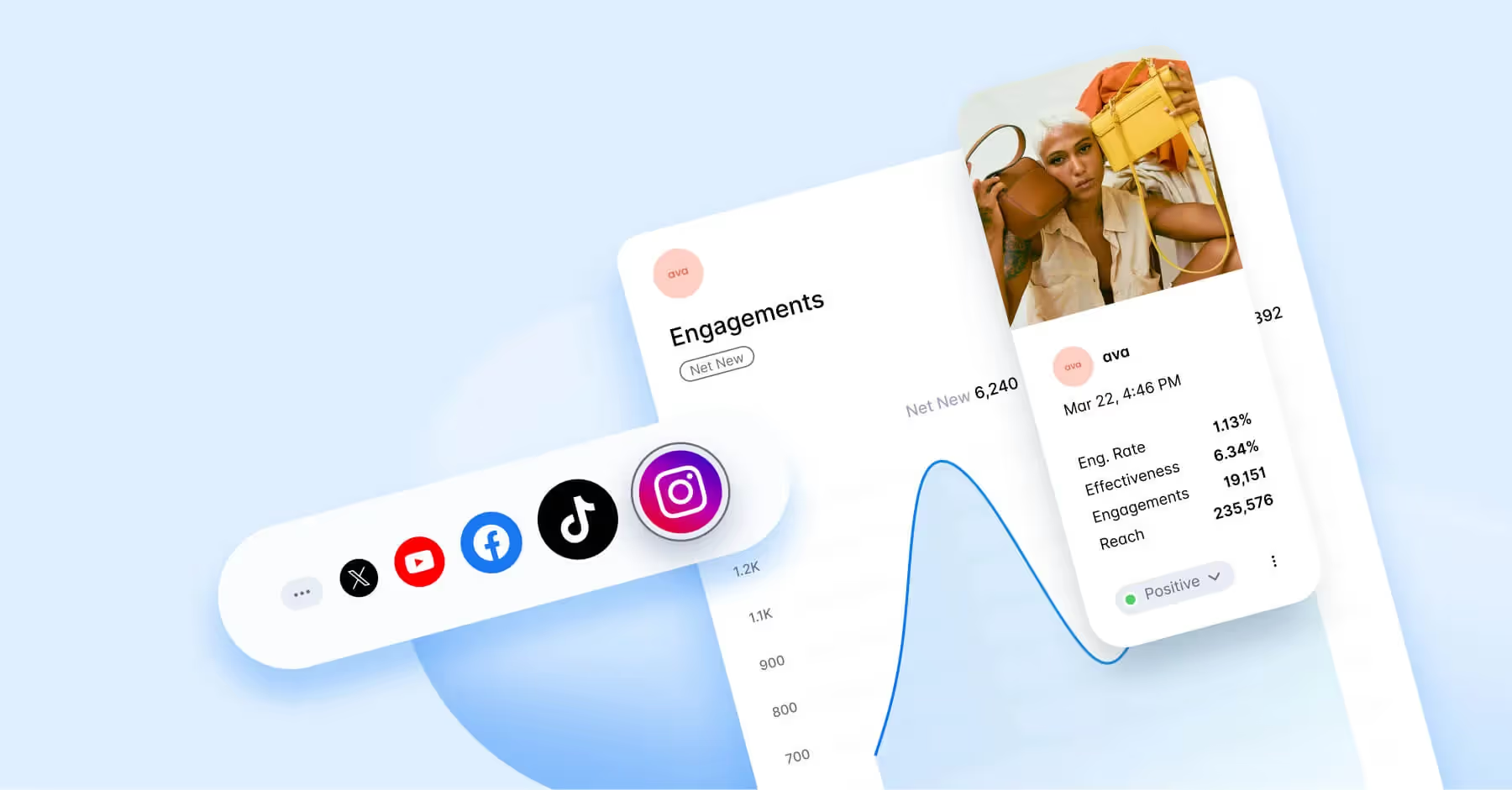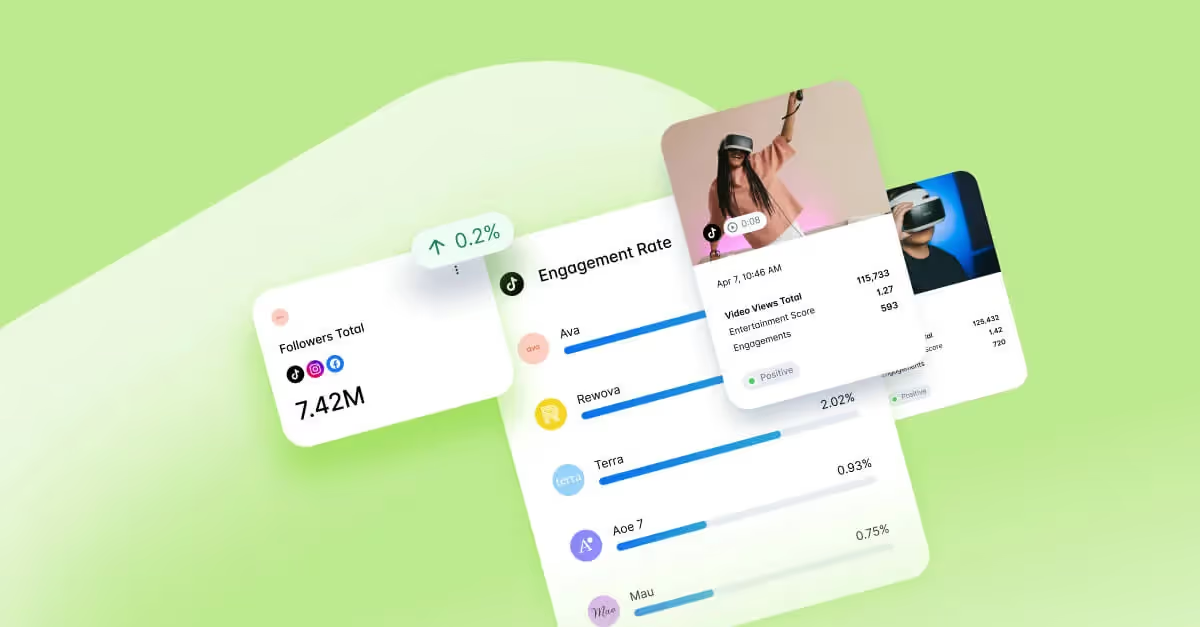Ultimate Brand Guide to Social Media Analytics
Explore how social media analytics tools help you monitor success and optimize your campaigns with precision.

Social media analytics provide the baseline for every single social media marketing tactic brands use to drive business. Without understanding where traffic comes from, who makes up your audience and which content drives engagement, how can you make informed decisions about social strategy? Simply put — you can’t.
Social media analytics separate guesswork from strategy. The insights you get allow you to move beyond hopeful posting and start sharing content you know will perform. While many marketers know what social media analytics are, understanding how they can drive action is another thing entirely.
Read on to look beneath the basics and discover how social media metrics can help achieve key objectives, goals and make insightful decisions.
TL;DR:
- Social media analytics turn guesswork into strategy by showing what content, audiences and tactics drive results.
- Four main social analytics types: descriptive, diagnostic, predictive and prescriptive; that work together to explain performance, forecast outcomes and guide action.
- Metrics span multiple focus areas, including audience insights, competitor benchmarking, paid campaign performance, influencer ROI and brand sentiment.
- Tracking the right KPIs helps brands optimize content, justify ROI and connect social efforts to business outcomes like conversions and sales.
- Social analytics tools like Dash Social streamline data collection, reporting and cross-platform analysis for smarter decision-making.
What Are Social Media Analytics?
Social media analytics are performance metrics gathered from social media platforms and tools that help you understand how your content performs. They include metrics like engagement, reach, impressions, follower growth and click-through rates, giving marketers the information they need to measure success and refine strategies.
These metrics also help marketers conduct in-depth social media analysis, such as competitive reports and content gap analyses to determine what tactics and content types are most effective. Allowing teams to double down on what works and quickly pivot away from strategies that don’t deliver results.
Why Are Social Media Analytics Important?
Social media analytics are important as they help your team optimize strategies and refine tactics based on real performance data. They provide valuable, actionable insights that support every stage of your social media strategy. With the right analytics in place, you can:
- Identify what types of content your audience likes
- Optimize posting times and frequency for better reach and engagement
- Benchmark against competitors and track industry trends
- Set measurable goals and monitor progress
- Justify social media ROI to stakeholders
- Understand audience behavior and preferences more deeply
- Spot issues early and pivot tactics as needed
Success with analytics for social media looks different for every brand. It all depends on the key performance indicators (KPIs) that are set. While some brands focus on engagement rates, others may value metrics like Entertainment Score. Increasingly, brands are treating their social feeds as an extension of their e-commerce platforms, using social commerce solutions to track sales, analyze customer behavior and gather deeper insights that connect content and conversions.
The Four Categories of Social Analytics
There are many different types of social analytics, but based on how the data is used, they usually fall into four main categories: descriptive, diagnostic, predictive and prescriptive. Each helps in its own way to understand performance and guide strategy.
1. Descriptive Analytics
Descriptive analytics answer the question, “What happened?” They summarize raw data into digestible metrics and visualizations using dashboards, charts, graphs, etc to categorize and communicate social media KPIs.
Examples include:
- Likes
- Comments
- Engagement rate
- Shares
- Views
- Completion rate
Nearly all types of analytics use some form of descriptive analytics data.
2. Diagnostic Analytics
Diagnostic analytics explore the ‘why’ something happened. They help you dig into underlying factors that impact performance.
For example, a diagnostic analytics tool might flag a sudden spike in views on one of your TikTok videos. That alert prompts you to dig deeper — where you might discover that a popular influencer shared, duetted or stitched your video, leading to a surge in engagement on your original content.
Examples of diagnostic analytics include:
- Audience demographics shifts
- Social listening insights
- Website traffic spikes from social channels
- Notable influencer engagement or UGC boosts
These insights help marketers uncover the drivers behind success or failure.
3. Predictive Analytics
Predictive analytics forecast what might happen next, based on historical patterns and current trends.
Examples include:
- Social media ROI or sales forecasting
- UGC engagement predictions
- Best time to post calculations
- AI-powered content performance forecasts
Predictive analytics help marketers plan ahead and prioritize their efforts.
4. Prescriptive Analytics
Prescriptive analytics recommend ‘what actions to take’. They build on predictive insights and go one step further by suggesting optimizations.
Let’s say you’re using a social media scheduling tool but aren’t sure when to post. Based on past engagement data, the tool might suggest the best times to publish. That’s prescriptive analytics in action — taking the guesswork out of decision-making.
Examples include:
- Best time to post recommendations (as mentioned above)
- Ad budget or boosting strategies
- Influencer and creator recommendations
- Hashtag suggestions
Prescriptive analytics is your data-driven game plan, this is where you turn insights into action.
What Are the Different Types of Social Media Analytics?
There are hundreds of social media metrics you can track, but the most important ones depend on your goals, strategy and business type. Below, we break down commonly tracked analytics by focus area and how each metric can impact your strategy.
Audience Analytics
Audience analytics reveal insights about the people engaging with your content. These metrics help you understand if you’re reaching your target demographic or uncover opportunities to reach new audience segments.
Common audience metrics include:
- Gender
- Age
- Location
- Device type
- Interests
These insights allow you to tailor your content strategy and make data-driven decisions about messaging, creative and platform targeting.
Competitor Analytics
Competitor analytics involves tracking metrics from your competitors to benchmark your performance and identify industry gaps or opportunities.
Examples of competitor analytics include:
- Follower growth
- Engagement metrics (views, likes, shares and comments)
- Benchmarking against industry averages
This type of analysis helps your team stay competitive and informed about social media trends and tactics in your niche.
Paid Social Analytics
Paid social analytics focus on measuring the performance of paid campaigns. These metrics help evaluate ROI and optimize your ad strategy.
Key paid social analytics metrics include:
- Conversion rate
- Cost per acquisition (CPA)
- Return on ad spend (ROAS)
- Budget recommendations
Tracking these metrics allows for smarter budget allocation and more impactful, creative and strategic decisions.
Influencer Analytics
Influencer analytics measures the performance of creator partnerships and influencer marketing campaigns. These insights help assess the impact and optimize future collaborations.
Metrics often include:
- Reach
- Click-through rate (CTR)
- Video views and average watch time
- Sales or affiliate link tracking
In order to maximize ROI from creator partnerships, understanding influencer performance is a must.
Monitoring Analytics
Monitoring analytics often referred to as social listening, track real-time conversations and sentiment around your brand or industry.
Common monitoring metrics include:
- Sentiment analysis
- Share of voice (SOV)
- Brand mentions
These types of analytics provide a clearer picture of how audiences feel about your brand and where you stand in broader social conversations.
What Are the Best Social Media Analytics Tools?
With so many tools on the market, the best option really comes down to the specific needs of your social media team, your organization and your broader business goals. Some tools excel at tracking engagement and audience growth, while others are better suited for analyzing ROI or optimizing content strategies. The best fit is the one that aligns with your overall objectives and helps you make decisions with confidence.
Here are three top-rated social media analytics tools (all with a 4-star+ rating on G2) that are widely used and loved by social media marketers.
1. Dash Social
Dash Social’s Social Analytics and Monitoring feature pulls in data from your owned, earned and paid media across all major platforms — giving you a full picture of what content is truly moving the needle.
You can create custom social media dashboards to segment data in a way that aligns with your strategy. For example, segmenting UGC and brand ambassadors separately helps you get a more accurate view of performance by content type.
Dash Social’s social media insights also offer demographic data along with commerce tools that let you link photos and videos to product pages — including UGC — using customizable UTMs. This makes it easy to measure the impact of your Shoppable Galleries and identify the best-converting placements.
Standout features:
- AI-powered insights
- Cross-platform analytics
- Visual performance tracking
2. Hootsuite
Hootsuite’s social analytics capabilities let you analyze hundreds of performance metrics at both the post and page level. A great tool for teams that want granular insights into what’s working and what’s not. With Hootsuite, you can build customizable reports that track performance across organic and paid campaigns.
Key features:
- Post and page-level insights
- Organic and paid tracking
- Customizable reports
3. Sprout Social
Sprout Social’s analytics tools give an overview of performance across platforms, with tools that allow brands to dive into engagement trends, audience demographics and campaign results in real time.
Highlights of Sprout Social’s analytics features include:
- Cross-platform insights
- Customizable reports
- Real-time data tracking
These three platforms are just the beginning. Each offers unique strengths that can support different aspects of your social strategy. To dive deeper and uncover even more options, check out our complete roundup of the 26 best social media analytics tools.
Social Media Analytics FAQs
How do I track social media analytics?
There are a number of methods to track your brand’s performance over time, including exporting .csv spreadsheets from the social channels themselves and calculating performance by hand. Many marketers choose to use an analytics tool to take the manual work out of measuring performance so that they can focus on doing their best creative work.
How do I choose an analytics tool?
There are hundreds of options, including the native analytics that various social channels offer. Ultimately, it comes down to determining your business needs and finding a social media analytics platform that fits your strategy — if your brand is committed to honing Instagram performance, it won’t make sense to choose an analytics tool that offers more capabilities for Snapchat than Instagram.
What’s the difference between social media analytics and social media data?
Social media analytics and data are often used interchangeably. However, ‘social media analytics’ often refers to the overall picture of social performance, like an analytics report, while social media data refers to the metrics included in these reports. Think of analytics as the whole picture, while data refers to individual metrics and numbers, like engagement rate or follower count.
.avif)





